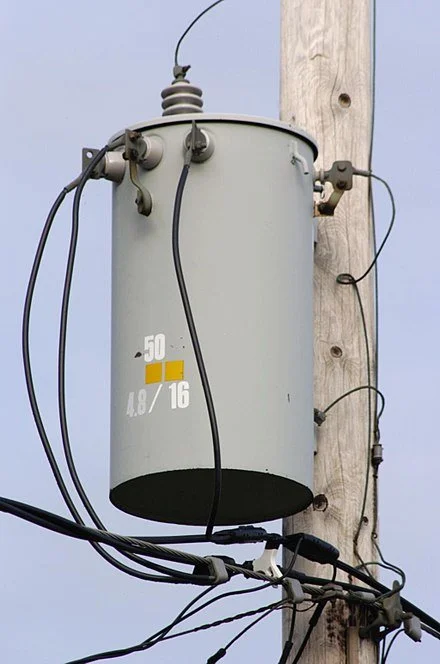Llewellyn King: Get ready for blackouts and brownouts in the great energy transition
Electricity-transmission line in western Connecticut — a common scene in New England’s wooded areas.
Pole transformer. There’s a shortage of these things.
A perfect storm is gathering over the electric utility industry in the United States. It may break this year, next year or the year after, but break it will.
That is the consensus from utility executives I have been talking to over the past month. Several issues together amount to a clear danger of widespread blackouts and brownouts in the coming years. They come under the rubric of “transition.”
There are, in fact, two transitions stretching the electric utility industry. One is the climate imperative to turn from fossil fuels, primarily coal and natural gas with a smidgeon of oil, to renewables, almost totally wind and solar.
The U.S. Energy Information Administration reckons that electricity from solar and wind will rise this year to 26 percent from 24 percent of national electricity, and that natural gas, the workhorse of the generation mix, will fall to 36 percent from 38 percent.The balance is dwindling coal use at 19 percent, and nuclear, hydro and geothermal generation making up the rest.
That leaves a significant need for new renewable generation: That is the first transition. It isn’t going as fast as the environmental lobby, or the Biden administration, would like, nor even as fast as the utilities would like. It has been substantially crimped by the supply chain tangle.
The American Public Power Association and the National Rural Electric Cooperative Association have been vocal about the shortage of pole transformers. The supply has dried up. Without transformers, new hookups are impossible and old ones are threatened if the transformers fail. The waiting list for something as simple as a bucket truck is three years.
Recent legislation has poured money at an unprecedented rate into the development of renewables, but none of it will help in the short term. It is a case of trying to force more of something into a bladder that is expanding too slowly and that can’t expand faster because of multiple restraints. A utility executive told me that the money is, if anything, making matters worse.
One of the things most concerning to the utilities is the fate of natural gas, both for its availability and price. Gas remains the principal go-to fuel for utilities. Many regard gas as a storage system even if they aren’t burning it to generate power daily.
Gas is special because it is relatively clean, it can be stored, and it can be installed in a short time at many locations. It doesn’t require trains, as does coal, and it works in any weather if the plants have been properly weatherized. Also, gas is very efficient to burn, so more of it can be transformed into electricity through so-called combined-cycle plants. It beats coal and nuclear hands down on the simplicity of the infrastructure it needs. Its efficiency is rated at about 64 percent versus 32 percent, or thereabouts, for coal.
Many utility executives believe that gas should be the primary way we store energy. They advocate maintaining a robust gas infrastructure so that it can come online quickly when needed and can run for as long as needed, unlike batteries.
But national gas policy is confusing. We want gas to be sent to Europe but not piped to New England, which may have an electricity deficit this winter, if not the next.
The second transition, working in tandem with the first, is electrification.
The United States is already headed toward a totally electrified transportation system, but heavy industry, like steel and cement, is also switching to electricity. Demand is showing the first signs of explosive growth. By 2050, demand will have more than doubled, according to many surveys.
While that alone is destabilizing, there is a wild card: the new unpredictable weather behavior.
This winter so far, we have had floods in California, freezing in Texas, tornadoes in the Midwest, and record snowfall in Buffalo. Add this to the other variables in electricity delivery, and you have a very troubling picture with such things as attacks on substations, cyberattacks and that pesky supply chain.
My advice: Keep spare batteries handy and a good supply of canned food. If you are sitting in the dark, you don’t want to be hungry.
On Twitter: @llewellynking2
Llewellyn King is executive producer and host of White House Chronicle, on PBS. He based in Rhode Island and Washington, D.C.

